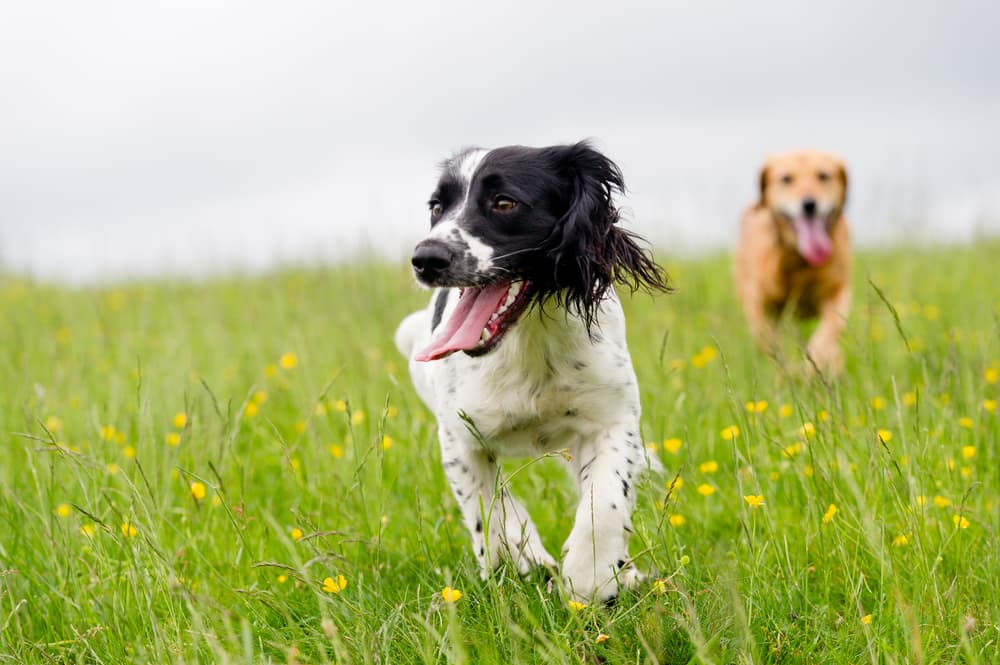Sponsored by Elanco
How Do Dogs Get Worms?

There are many different types of worms that can cause health problems in dogs. Many worms in dogs are intestinal parasites that are found in a dog’s gut, but some worms infect other bodily systems or organs such as the heart.
Worms in dogs may cause mild symptoms, such as diarrhoea or more serious symptoms, like blood loss or heart disease.
If you suspect your dog has worms, fast treatment is necessary to keep her from becoming ill and to prevent the spread of infection.
Types of Worms in Dogs
Depending upon where you live, the most common types of worms that infect dogs can be intestinal worms, some of which migrate through multiple tissues before reaching the intestines, or lungworms, which live in the large vessels near the heart.
Some of the most common worms in dogs include:
Roundworms
Roundworms are intestinal worms that live inside a dog’s intestines. They are cylindrical in shape, often coiling up into a circle. Adult roundworms grow 15cm long (1). They are very common in puppies. These intestinal parasites often cause symptoms such as diarrhoea or vomiting.
Tapeworms
Tapeworms are flat-bodied worms that vary greatly in size, depending upon the species. For instance, adult Echinococcus tapeworms are tiny, at only 1 to 7 millimetres, but the larval form can cause severe disease and death in people. Adult Taenia, on the other hand, can reach up to a staggering 5 meters in length (2).
Tapeworms attach to the inside of a dog’s intestines and absorb nutrients. It is uncommon for tapeworms to cause your dog to feel ill, but a tapeworm infection can cause itching around the anal area.
Lungworms (1)
Lungworm (Angiostrongylus vasorum) is of growing concern for dogs. Cases of lungworm are on the rise, especially in warmer, wetter areas. Lungworm adults are approximately 14 to 20 millimetres long and live in the vessels of the heart, where they can cause serious problems (1).
Unfortunately, one of the difficult things about lungworm is that the symptoms are non-specific and even vague. Coughing, shortness of breath and blood that doesn’t effectively clot are all signs. More extreme signs include fluid in the abdomen, seizures, collapse and death. At first, symptoms may only appear in dogs exercising, but as the infestation progresses, symptoms will appear even in dogs at rest.
How Do Dogs Get Roundworms? (1)

Practically every puppy is born with roundworms. That’s because dormant larvae in the mother’s bodily tissues can reactivate during pregnancy and transfer to her pups through the placenta.
Adult dogs frequently get roundworms by eating small animals like birds or rodents, or by eating soil or other items contaminated by eggs from other infected dogs. Unlike tapeworm eggs, which are immediately infective when passed, roundworm eggs must mature for a couple of weeks in the environment to become infective.
Once the worm eggs are inside your dog, they hatch into worms and travel through the liver, lungs and then into the intestines. These adult worms attach themselves to the lining of the intestines, feed on partially-digested food and lay eggs to be passed out into your dog’s poo.
Once roundworm eggs are in the environment, they can infect other dogs for years. Roundworm eggs can survive in soil long after the dog poo is gone. It’s hard to spot which areas outside are contaminated, as the eggs are far too small (microscopic, in fact) to be seen with the naked eye.
How Do Dogs Get Tapeworms? (1)

Tapeworms require an intermediate host, such as fleas, rabbits, rodents, livestock or wildlife, before they can infect your dog. Multiple types of tapeworms can affect dogs.
Fleas are the most common source of Dipylidium caninum tapeworm infections in dogs. Your dog can become infected if he accidentally eats a flea that’s infected with tapeworm larvae.
Dipylidium caninum sheds sacks of eggs, or segments, that may look like flat, white worms in dog poo. These tapeworm segments are about the size and appearance of a grain of rice. In addition to seeing these segments in a dog’s stool, many pet parents notice these egg sacks (that look like rice) in the fur underneath the tail or on the back of the legs.
If your dog enjoys hunting or chasing small animals, such as rabbits and rodents, he could be at risk for contracting Echinococcus or Taenia tapeworm infections. Your dog can become infected after eating a small host carrying tapeworm eggs.
Even if you do not see the egg sacks on your dog, she may still be infected with tapeworms.
How Do Dogs Get Lungworm? (1)

Dogs get lungworm by eating the larvae. These are found in slugs and snails. If a dog eats the slug or even eats another animal that has eaten the slug, they swallow the larvae. These larvae burrow through the gut wall and migrate to the heart as the larvae turn into adults.
The adult lungworms actually live in the large vessels near the heart. They attach here and feed, then produce eggs. These eggs quickly hatch and the juvenile larvae migrate through the lung tissue before being coughed up and swallowed again by the dog. They pass in the faeces, where they’re eaten by slugs and snails and the process starts again. It takes around 5 to 6 weeks for the lifecycle to complete.
Foxes can carry and spread lungworm into new gardens, meaning suburban and urban areas with a high concentration of foxes have a higher risk.
How to Protect Your Dog from Worms

Protecting your dog from worms by regularly deworming them with a broad-spectrum dewormer is much safer and easier than treating your dog after he has been diagnosed and having to deal with the illness that could accompany that infection.
Give Your Dog Monthly Parasite Protection
Those wondering how to protect against worms in dogs, should ask their vet about year-round, broad-spectrum parasite protection that protects against multiple worms, such as roundworms, tapeworms and lungworms.
 Monthly flea control can also help protect your dog against flea tapeworm infections by killing fleas. Ask your vet about a chewable tablet that protects against fleas and ticks.
Monthly flea control can also help protect your dog against flea tapeworm infections by killing fleas. Ask your vet about a chewable tablet that protects against fleas and ticks.
Be sure to visit your veterinary clinic to discuss the right products for your pet.
Schedule Regular Veterinary Visits
Your vet can evaluate your dog’s overall health and check your dog for ticks and fleas. Even in winter, ticks and fleas need to be controlled regularly. If your vet finds ticks or fleas on your dog, he or she can offer tips on how to best clean your living space.
Keep Your Dog and Home Clean
Other ways to protect against worms include picking up your dog’s poo right away and making sure parks and walking routes are free of dog faeces. Dogs can be infected by contaminated environments. The issue remains that infective eggs can live for years, long after the faeces is gone.
The scientific content of these articles is referenced by ESCCAP Guideline 1 (worm control in Dogs and Cats) which can be accessed: https://www.esccap.org/uploads/docs/2fe4poh6_0778_ESCCAP_Guideline_GL1_v10_1p.pdf.
For further information call Elanco Animal Health on +44(0)1256 353131 or write to: Elanco UK AH Limited, Form 2, Bartley Wood Business Park, Hook, RG27 9XA, United Kingdom. Elanco is a trademark of Elanco or its affiliates © 2020 Elanco or its affiliates. PM-IE-20-0082. Date of preparation 03/20.
REFERENCES:
- Worm Control in Dogs and Cats ESCCAP Guidelines 01 Third Edition* – July 2017
- Taylor MA et al, (2007) Veterinary parasitology




